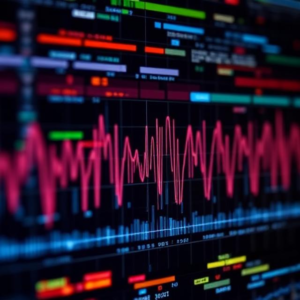Advanced Digital Signal Processing (DSP) Basics – A Brief Summary
1. Introduction to Digital Signal Processing (DSP)
Digital Signal Processing (DSP) involves the manipulation of signals, such as sound, images, and video, that have been converted into a digital form. It involves algorithms and mathematical models used to process signals to extract useful information, enhance the signal, or transform it for various applications like audio processing, telecommunications, and medical diagnostics.

Unlike analog signal processing, which uses continuous signals, DSP works with discrete signals that are represented by numbers and processed using digital systems like computers or dedicated DSP hardware.
2. Key Concepts in DSP
-
Discrete Time Signals: Signals that are sampled at discrete intervals of time. For instance, audio signals sampled at 44.1 kHz (44,100 samples per second).
-
Sampling: The process of converting a continuous-time signal into a discrete-time signal by measuring its amplitude at specific intervals. The sampling theorem ensures that a signal can be accurately reconstructed if it is sampled at twice the maximum frequency (Nyquist Rate).
-
Quantization: This refers to the process of mapping the continuous values of the signal into a finite set of discrete values. This leads to rounding errors and quantization noise.
-
Digital Filtering: Digital filters process a discrete-time signal to remove noise or enhance certain features. Filters can be FIR (Finite Impulse Response) or IIR (Infinite Impulse Response). FIR filters have finite duration impulse responses, while IIR filters have feedback, leading to infinite duration responses.
-
Z-Transform: The Z-transform is a powerful mathematical tool used to analyze discrete-time systems. It helps in solving difference equations and is a key concept for analyzing and designing digital filters. It generalizes the discrete Fourier transform (DFT) and is used to represent and manipulate signals in the complex frequency domain.
3. Important DSP Techniques
-
Convolution: This is a mathematical operation used to combine two signals and find the output of a linear time-invariant (LTI) system. Convolution is essential in filter design, where it determines how an input signal is transformed by the system.
-
Fourier Transform: The Fourier Transform, particularly the Discrete Fourier Transform (DFT) and Fast Fourier Transform (FFT), is used to convert a signal from the time domain to the frequency domain. It allows analysis of the frequency components of a signal.
-
Windowing: A technique used to reduce the side effects of the Fourier Transform, particularly the leakage effect. A window function (like Hamming or Hanning window) is applied to a signal before performing FFT to improve frequency resolution.
4. Digital Filter Design
One of the most important areas of DSP is digital filter design. Filters can be used to:
-
Remove noise (e.g., low-pass filters to remove high-frequency noise),
-
Enhance certain frequencies (e.g., band-pass filters for communication signals),
-
Shape signals for better transmission or interpretation.
There are two primary types of digital filters:
-
FIR (Finite Impulse Response) Filters: FIR filters are stable and always have a finite duration impulse response. They are easy to design and implement but may require more computational resources for sharp cutoff characteristics.
-
IIR (Infinite Impulse Response) Filters: IIR filters are more computationally efficient and can achieve similar performance with fewer coefficients compared to FIR filters. However, they can be less stable and more challenging to design.
5. Applications of DSP
DSP is used in a wide range of fields. Some common applications include:
-
Audio Processing: Speech recognition, noise cancellation, equalization, and compression.
-
Image and Video Processing: Compression (JPEG, MPEG), enhancement, filtering, and object recognition.
-
Communication Systems: Modulation, demodulation, error correction, and digital signal transmission.
-
Medical Signal Processing: ECG and EEG signal analysis for diagnosing heart conditions or brain activity.
-
Radar and Sonar: Used in detecting objects, monitoring movement, and identifying distances.
6. Challenges in DSP
While DSP has many advantages, it also has some challenges:
-
Computational Complexity: Some DSP algorithms can be computationally intensive, requiring fast processors or specialized hardware.
-
Noise and Interference: Signals are often corrupted by noise, making it difficult to achieve perfect signal recovery or processing.
-
Real-Time Processing: Many DSP applications, like audio and video processing, require real-time processing, which poses challenges in ensuring fast and efficient computation.
7. Recent Advances in DSP
Recent developments in DSP have been influenced by advances in hardware (such as more powerful processors, GPUs, and specialized DSP chips) and software techniques:
-
Machine Learning and AI in DSP: Machine learning algorithms are increasingly being used for tasks like noise cancellation, signal classification, and predictive analysis in DSP systems.
-
Software-Defined Radio (SDR): SDR allows for the flexibility to change the communication system through software, which is an exciting development in wireless communication.
-
Real-Time DSP: There is a growing emphasis on real-time DSP for applications such as augmented reality (AR), virtual reality (VR), and high-definition video streaming.
8. Conclusion
Advanced DSP is a powerful field that bridges mathematics, engineering, and computer science. By applying algorithms to digital signals, it allows for efficient processing, transformation, and analysis of signals in many applications. Understanding the basics of DSP is crucial for designing robust systems in fields ranging from telecommunications to medical diagnostics. The field continues to evolve, particularly with the integration of machine learning and real-time capabilities, pushing the boundaries of what is possible with digital signals.











